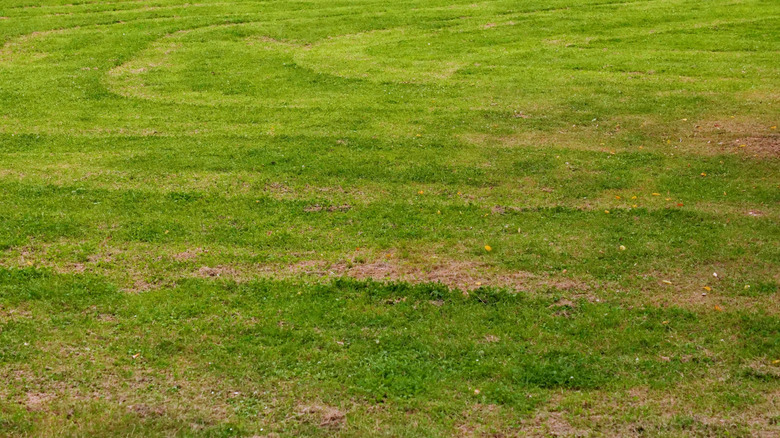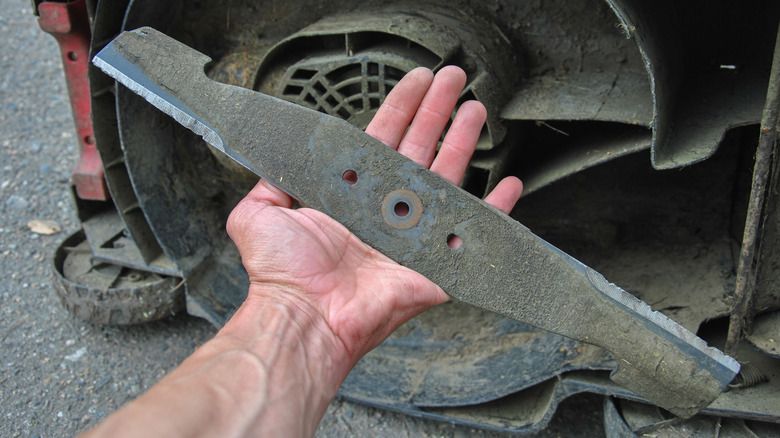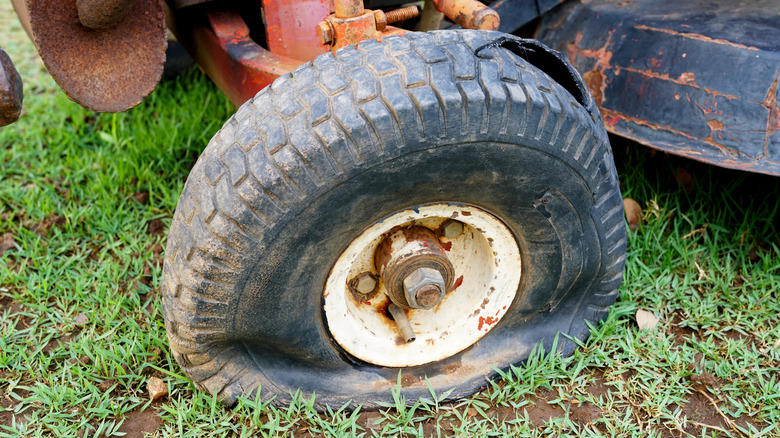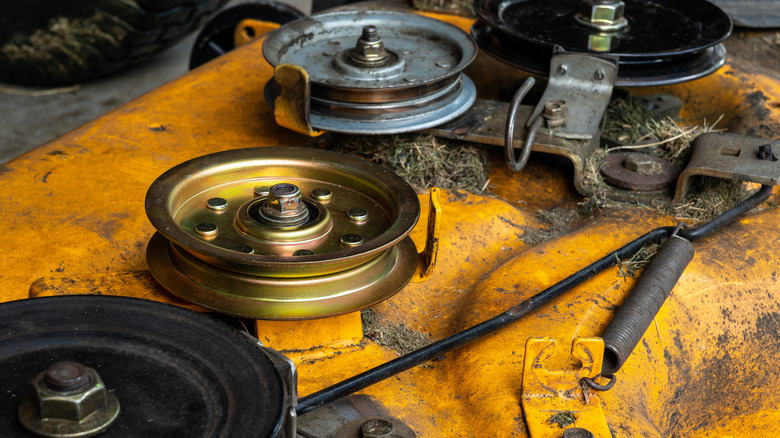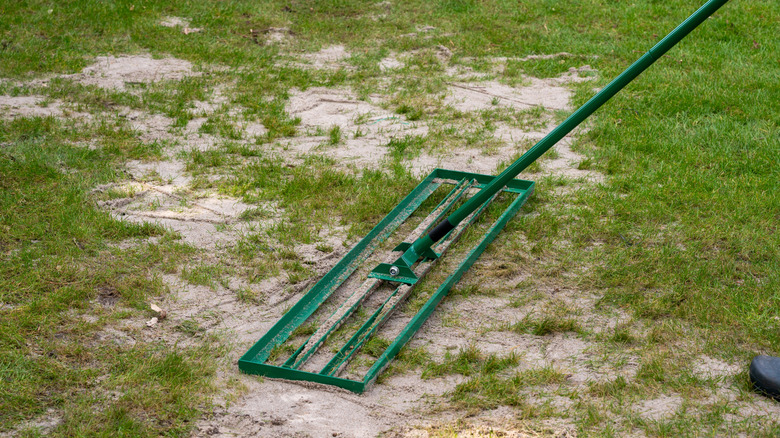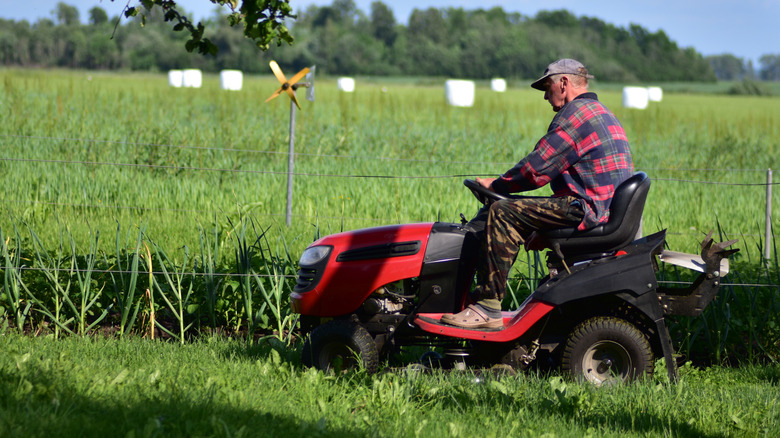Why Your Mower Is Cutting Unevenly (& What To Do About It)
It's one of those small disappointments that can drive a person to the empty consolation of a lawn care service. You've gotten your mower running, the weather has finally abated, and you've freed up a few hours to give the yard a good mow and trim. On the second pass, you notice that the right side of your cut is about ⅛ inch tall, or there's a thin strip that's not getting cut at all, or you're somehow digging a furrow down the middle of your lawn. What gives?
There are only three pieces of the puzzle: you, the lawn, and the mower. Naturally you assume the problem is with the mower, and you're probably right. But it could be any of them, or all three working together to make sure your lawn looks like it was mowed by a guy on a unicycle wielding a scythe. Some of the causes are obvious, like dull or damaged blades and tires that are worn or have uneven air pressure, and some are obvious once you understand what's going on under the mower deck — like a blockage caused by grass debris. None of them are particularly difficult to remedy, assuming you don't need a whole new mower or a landscape grading service. And if there's any good news, it's that you probably don't need a landscape grading service, with many of these issues solved by regular blade sharpening, maintenance, or cleaning. One heads up: We're mostly discussing riding mowers here. Many of these issues also apply to walk-behind mowers, but some — the discussion of suspended mower decks, for example — obviously do not.
Dull or damaged mower blades
We kid. Chances are the problem is very simple, and very simple to fix, which is definitely good news. When you're mowing a lawn, most of the action happens where the blade and the grass briefly intersect, and the condition of your mower's blade is a likely culprit in uneven cuts. This can be because of dull or damaged blades, blades that are improperly secured to the mower, or ones that aren't balanced. Dull or damaged blades are the easiest to deal with. If you're so inclined, you can usually sharpen the blades or have them sharpened for you. Bent blades, or those so damaged they can no longer be properly sharpened (you gotta stop mowing gravel!), will need to be replaced.
Always start by disconnecting the spark plug before tasks like changing lawn mower blades. To make sure the blade is properly secured, use a block of wood to keep the blade from moving and use a wrench or socket and ratchet to tighten it. Balancing the blade is a bit more of a challenge. First, remove the blade and attempt to balance it either on a balancing cone or your finger to see if one end of the blade dips more than the other. Use a file to remove small amounts of metal from the heavier side of the blade. File the top or bottom of the blade, and check frequently for balance. Don't file the cutting edge. You can also have a service — some blade makers, many hardware stores, and most small engine repair shops — sharpen and balance your blades.
Tire problems
Blades are where your mower's metaphorical rubber meets the road, but the actual tires matter a lot, too. There are two main scenarios in which tire problems can contribute to an uneven cut. The first, most obvious, and least expensive to remedy is uneven air pressure in your mower's tires. Tire pressure issues can be extremely frustrating because they can make a lawn mower handle poorly (especially the front tires), but in some circumstances they can also cause one side of your mower deck to ride lower than the other. Since low tire pressure can also contribute to tire wear and even lawn damage, it's a good idea to check and even out your tire pressure before each use of the mower.
The other situation in which tires can contribute to a streaky, uneven cut is when the tires are worn. This results in poor or uneven traction, and while floating mower decks can prevent uneven tire pressure from messing up your mowing mojo, they can also dip and otherwise move unpredictably when you lose traction, contributing to an uneven cut. Poor traction can also tear up your turfgrass, so as much as it hurts to invest in new mower tires, sometimes it's the best solution.
Mower deck issues
Many homeowners probably think a little about mower deck width and cutting height, and otherwise don't give a lot of thought to this crucial bit of lawn mowing mechanics. The deck is more complicated than it looks, and it's stacked to result in an uneven cut if you don't keep an eye on each component. Fortunately, most of this is easy. A worn blade belt can result in uneven cuts, and that's easily remedied by replacing the belt. Surprisingly, a mower deck caked with dried grass clippings can also cause it to cut unevenly because the debris interferes with proper airflow, which helps grass blades be lifted properly during cutting and ejected properly afterward. So, a lawn mower maintenance task you should be doing after every mow is keeping your mower deck clean.
Lawn scalping and step cutting can also result from a mower deck that is misaligned — that is, one that doesn't ride level. To level your mower deck, part it on a level, paved surface and make sure all the tires have equal air pressure. With the blades positioned both front-to-back and side-to-side, measure the distance from each blade tip to the surface you're parked on. If you find a difference of ¼ inch or more, make adjustments according to your deck's owner's manual.
Finally, check any parts that might influence the angle or performance of your mower blades. Bearings and spindles (the assemblies that hold the blade in place) can be damaged or can wear over time, resulting in an unbalanced cut. Replace any parts that are worn, bent, or otherwise damaged.
The lay of the land
This one might be unexpected, but the shape of your lawn, and the shape it's in, can both contribute to an uneven cut. The first step in fixing this problem is to visualize the problem itself. Imagine a mower deck — say, 54 inches wide — moving by itself right on the ground along various parts of your lawn. Where there's much unevenness, you'll see that either the center of the deck or one or both edges of the deck will be off the ground, while the other parts touch. This unevenness can express itself as anything from grass of different heights to scalping areas of your lawn. A free-floating deck will help, but there's no escaping the basic physics.
Here you have two choices. You can level your lawn or adjust your mowing technique. We'll come back to technique in a moment. Lawn-leveling can involve anything from having your yard graded to DIY leveling with topdressing and a lawn rake. You might also get some benefit from adding casters to your mower deck. It's a relatively simple operation if you're comfortable with drilling metal. At a minimum, casters — also known as anti-scalp wheels — will prevent the worst of the scalping in many areas.
Bad technique
Perhaps the least welcome thought in all this is that you might have habits that are contributing to your uneven lawn mowing. Remember this mantra: Run engine fast, move engine slowly. If your engine is directly connected to your blade(s), as with most walk-behind mowers, you should run your engine at full throttle. It's a little more complicated with riding mowers, but full throttle doesn't mean full speed, and is generally a good idea if you don't mind using the extra gas. Not operating the blade(s) at full speed undermines the mower deck's lifting and airflow capabilities. But you shouldn't operate the mower itself at full speed, which can result in tilting and bouncing of the mower deck and some inevitable scalping.
Here are some general rules for operating a mower with minimal unevenness to the cut. Slow down. Make wide turns if you don't have a floating deck; otherwise, you'll risk tilting. In areas of uneven ground, overlap your cuts so that each bit of grass gets both the high side and low side of your deck. And cut at a right angle to the slope, particularly at the bottoms and tops of hills where you're likely to dig into or scalp the lawn.
